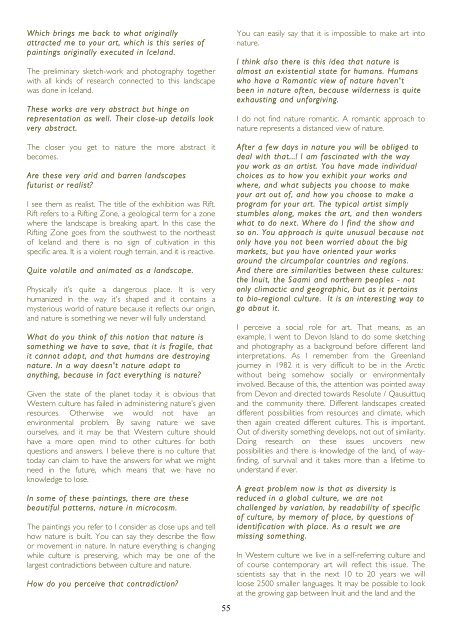M - Antennae The Journal of Nature in Visual Culture
M - Antennae The Journal of Nature in Visual Culture
M - Antennae The Journal of Nature in Visual Culture
Create successful ePaper yourself
Turn your PDF publications into a flip-book with our unique Google optimized e-Paper software.
Which br<strong>in</strong>gs me back to what orig<strong>in</strong>ally<br />
attracted me to your art, which is this series <strong>of</strong><br />
pa<strong>in</strong>t<strong>in</strong>gs orig<strong>in</strong>ally executed <strong>in</strong> Iceland.<br />
<strong>The</strong> prelim<strong>in</strong>ary sketch-work and photography together<br />
with all k<strong>in</strong>ds <strong>of</strong> research connected to this landscape<br />
was done <strong>in</strong> Iceland.<br />
<strong>The</strong>se works are very abstract but h<strong>in</strong>ge on<br />
representation as well. <strong>The</strong>ir close-up details look<br />
very abstract.<br />
<strong>The</strong> closer you get to nature the more abstract it<br />
becomes.<br />
Are these very arid and barren landscapes<br />
futurist or realist?<br />
I see them as realist. <strong>The</strong> title <strong>of</strong> the exhibition was Rift.<br />
Rift refers to a Rift<strong>in</strong>g Zone, a geological term for a zone<br />
where the landscape is break<strong>in</strong>g apart. In this case the<br />
Rift<strong>in</strong>g Zone goes from the southwest to the northeast<br />
<strong>of</strong> Iceland and there is no sign <strong>of</strong> cultivation <strong>in</strong> this<br />
specific area. It is a violent rough terra<strong>in</strong>, and it is reactive.<br />
Quite volatile and animated as a landscape.<br />
Physically it’s quite a dangerous place. It is very<br />
humanized <strong>in</strong> the way it's shaped and it conta<strong>in</strong>s a<br />
mysterious world <strong>of</strong> nature because it reflects our orig<strong>in</strong>,<br />
and nature is someth<strong>in</strong>g we never will fully understand.<br />
What do you th<strong>in</strong>k <strong>of</strong> this notion that nature is<br />
someth<strong>in</strong>g we have to save, that it is fragile, that<br />
it cannot adapt, and that humans are destroy<strong>in</strong>g<br />
nature. In a way doesn't nature adapt to<br />
anyth<strong>in</strong>g, because <strong>in</strong> fact everyth<strong>in</strong>g is nature?<br />
Given the state <strong>of</strong> the planet today it is obvious that<br />
Western culture has failed <strong>in</strong> adm<strong>in</strong>ister<strong>in</strong>g nature’s given<br />
resources. Otherwise we would not have an<br />
environmental problem. By sav<strong>in</strong>g nature we save<br />
ourselves, and it may be that Western culture should<br />
have a more open m<strong>in</strong>d to other cultures for both<br />
questions and answers. I believe there is no culture that<br />
today can claim to have the answers for what we might<br />
need <strong>in</strong> the future, which means that we have no<br />
knowledge to lose.<br />
In some <strong>of</strong> these pa<strong>in</strong>t<strong>in</strong>gs, there are these<br />
beautiful patterns, nature <strong>in</strong> microcosm.<br />
<strong>The</strong> pa<strong>in</strong>t<strong>in</strong>gs you refer to I consider as close ups and tell<br />
how nature is built. You can say they describe the flow<br />
or movement <strong>in</strong> nature. In nature everyth<strong>in</strong>g is chang<strong>in</strong>g<br />
while culture is preserv<strong>in</strong>g, which may be one <strong>of</strong> the<br />
largest contradictions between culture and nature.<br />
How do you perceive that contradiction?<br />
55<br />
You can easily say that it is impossible to make art <strong>in</strong>to<br />
nature.<br />
I th<strong>in</strong>k also there is this idea that nature is<br />
almost an existential state for humans. Humans<br />
who have a Romantic view <strong>of</strong> nature haven't<br />
been <strong>in</strong> nature <strong>of</strong>ten, because wilderness is quite<br />
exhaust<strong>in</strong>g and unforgiv<strong>in</strong>g.<br />
I do not f<strong>in</strong>d nature romantic. A romantic approach to<br />
nature represents a distanced view <strong>of</strong> nature.<br />
After a few days <strong>in</strong> nature you will be obliged to<br />
deal with that...! I am fasc<strong>in</strong>ated with the way<br />
you work as an artist. You have made <strong>in</strong>dividual<br />
choices as to how you exhibit your works and<br />
where, and what subjects you choose to make<br />
your art out <strong>of</strong>, and how you choose to make a<br />
program for your art. <strong>The</strong> typical artist simply<br />
stumbles along, makes the art, and then wonders<br />
what to do next. Where do I f<strong>in</strong>d the show and<br />
so on. You approach is quite unusual because not<br />
only have you not been worried about the big<br />
markets, but you have oriented your works<br />
around the circumpolar countries and regions.<br />
And there are similarities between these cultures:<br />
the Inuit, the Saami and northern peoples - not<br />
only climactic and geographic, but as it perta<strong>in</strong>s<br />
to bio-regional culture. It is an <strong>in</strong>terest<strong>in</strong>g way to<br />
go about it.<br />
I perceive a social role for art. That means, as an<br />
example, I went to Devon Island to do some sketch<strong>in</strong>g<br />
and photography as a background before different land<br />
<strong>in</strong>terpretations. As I remember from the Greenland<br />
journey <strong>in</strong> 1982 it is very difficult to be <strong>in</strong> the Arctic<br />
without be<strong>in</strong>g somehow socially or environmentally<br />
<strong>in</strong>volved. Because <strong>of</strong> this, the attention was po<strong>in</strong>ted away<br />
from Devon and directed towards Resolute / Qausuittuq<br />
and the community there. Different landscapes created<br />
different possibilities from resources and climate, which<br />
then aga<strong>in</strong> created different cultures. This is important.<br />
Out <strong>of</strong> diversity someth<strong>in</strong>g develops, not out <strong>of</strong> similarity.<br />
Do<strong>in</strong>g research on these issues uncovers new<br />
possibilities and there is knowledge <strong>of</strong> the land, <strong>of</strong> wayf<strong>in</strong>d<strong>in</strong>g,<br />
<strong>of</strong> survival and it takes more than a lifetime to<br />
understand if ever.<br />
A great problem now is that as diversity is<br />
reduced <strong>in</strong> a global culture, we are not<br />
challenged by variation, by readability <strong>of</strong> specific<br />
<strong>of</strong> culture, by memory <strong>of</strong> place, by questions <strong>of</strong><br />
identification with place. As a result we are<br />
miss<strong>in</strong>g someth<strong>in</strong>g.<br />
In Western culture we live <strong>in</strong> a self-referr<strong>in</strong>g culture and<br />
<strong>of</strong> course contemporary art will reflect this issue. <strong>The</strong><br />
scientists say that <strong>in</strong> the next 10 to 20 years we will<br />
loose 2500 smaller languages. It may be possible to look<br />
at the grow<strong>in</strong>g gap between Inuit and the land and the












